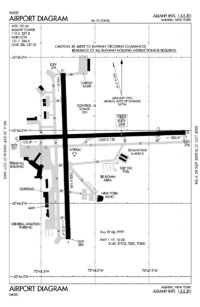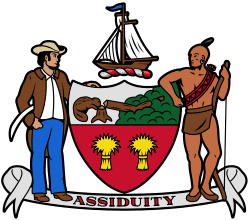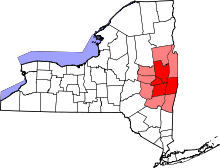Albany International Airport
| Albany International Airport | |||||||||||||||
|---|---|---|---|---|---|---|---|---|---|---|---|---|---|---|---|
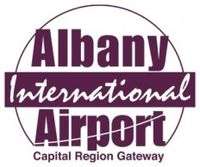 | |||||||||||||||
|
FAA airport diagram | |||||||||||||||
|
IATA: ALB – ICAO: KALB – FAA LID: ALB  ALB | |||||||||||||||
| Summary | |||||||||||||||
| Airport type | Public | ||||||||||||||
| Owner | Albany County | ||||||||||||||
| Operator | Albany County Airport Authority | ||||||||||||||
| Serves | Albany, New York | ||||||||||||||
| Location | Colonie, New York | ||||||||||||||
| Focus city for | Cape Air | ||||||||||||||
| Elevation AMSL | 285 ft / 87 m | ||||||||||||||
| Coordinates | 42°44′57″N 073°48′07″W / 42.74917°N 73.80194°W | ||||||||||||||
| Website | www.albanyairport.com | ||||||||||||||
| Runways | |||||||||||||||
| |||||||||||||||
| Statistics (2010) | |||||||||||||||
| |||||||||||||||
Albany International Airport (IATA: ALB, ICAO: KALB, FAA LID: ALB) is a public airport seven miles (11 km) northwest of Albany, in Albany County, New York, United States. It is owned by the Albany County Airport Authority.[1]
It is an Airport of Entry[3] in the town of Colonie. It was built on the site of the Shaker settlement about 6 miles (10 km) north of Albany and stretching north to the hamlet of Verdoy. The airport is below class C airspace.[4]
In the past, most airlines operated mainline aircraft to ALB. The biggest aircraft that flew into ALB was Air Force One (Boeing 747), which has made four appearances: in 1994, 2009, 2011, and again in 2012. The C-5 Galaxy has landed for training, for cargo during Hurricane Katrina, and for the transportation of President Obama's motorcade on September 20 and 21, 2009. An Air Canada Airbus A340-300 (which has seating for 286 passengers) made an unscheduled arrival on December 21, 2007. Also, on August 10, 2012, a United Airlines Boeing 767-400 flight from Munich, Germany was diverted to Albany due to bad weather conditions at Newark Liberty International Airport in New Jersey where the flight was expected to land.
Many times a week, UPS runs a 757-200 for cargo. FedEx Airlines brings the Boeing 757-200 to the airport about 5 times a week for cargo. Today, about half of the planes that depart and land in ALB are regional aircraft. Airlines that operate mainline aircraft are American Airlines, American Eagle, Cape Air, Delta Airlines, JetBlue Airways, Southwest Airlines and United Airlines. The largest passenger aircraft to fly into ALB on a year-round daily basis is the Boeing 737-800 operated by Southwest Airlines.
History
Albany International was the first, and remains the oldest, municipal airport in the United States. In 1908 the airstrip was on a former polo field on Loudonville Road, three miles (5 km) north of the city in the town of Colonie. In 1909 the airport moved to Westerlo Island, in the city of Albany, but at that time was in the town of Bethlehem; the airport was named at this time. The airport was named after Teddy Roosevelt's son, Quentin, a fighter pilot during World War I. A $10,000 prize was established for sustained flight between Albany and New York City; Glenn Curtiss achieved this on May 29, 1910. Other early pioneers of aviation that stopped at this early field were Charles Lindbergh, Amelia Earhart, and James Doolittle.
Mayor John Boyd Thacher II once said "a city without the foresight to build an airport for the new traffic may soon be left behind in the race for competition". He therefore decided to build in 1928 a new modern airport on the Shaker site near Albany-Shaker Road in Colonie, not far from the original polo fields used as the first site of the municipal airport. The Shakers not only sold the land used but also loaned the use of tractors and tools.
The early Albany Airport was often closed and threatened with closure which prompted repeated improvements in the late 1930s and 1940s. The airport was closed from January 1939 until December 1940, when it reopened to traffic during daylight hours only, and then with no restrictions since January 1942. The airport has not been closed (other than for weather and emergency landings) since.
The February 1947 C&GS chart shows three 3500-ft runways aimed 12, 98 and 133 degrees magnetic.
ALB was jointly owned and managed by the city and county of Albany until 1960 when Mayor Erastus Corning 2nd ended the city's stake.
In 1962 a new terminal building opened. A landside building had ticket counters, a coffee shop, and baggage claim on the first floor and a restaurant, offices and viewing area on the second floor. A single-story boarding concourse extended outwards from this building. In 1968 this concourse was widened to allow more concessions and boarding space. The terminal was expanded again in 1979, with the addition of a new two-story building attached diagonally to the northwest. It had boarding gates for Allegheny Airlines on the second floor, and baggage carousels on the first floor.
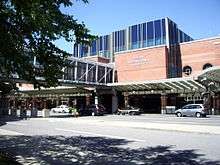
The Albany County Airport Authority was created by the county in 1993 with a 40-year lease to operate the airport in 1996. Construction of a new terminal began on May 16, 1996 and opened in June 1998. It was designed by Reynolds, Smith & Hills and Stracher-Roth-Gilmore,[5] and it was built around the existing terminal, most of which was demolished upon its completion. Only the 1979 extension remains from the old terminal building.[6]
In 1999, the Airport Authority began construction of a 16,000 sq. ft. addition to the new terminal to accommodate Southwest Airlines. The project was completed in 2000 and included the addition of two new dual jet bridges enabling passengers to board and deplane from the front and rear of the aircraft.[7]
Service history
At the time of US airline deregulation in 1978, most of Albany's service was provided by two "trunk carriers" (American Airlines and Eastern Air Lines) and one "local service carrier" (Allegheny Airlines, which renamed itself USAir in 1979). After deregulation, many new airlines expanded to Albany. Most did not survive the tumultuous 1980's.
Airlines that served Albany after deregulation include:
- Braniff International Airways, which added Albany as part of an unsuccessful large expansion in 1979. Albany was the only Upstate New York market served by this colorful and storied Dallas-based airline, which shut down in 1982.
- Empire Airlines, a regional carrier based in Utica, opened a hub at Syracuse Hancock International Airport after deregulation and operated flights from Albany and numerous destinations in the Northeast with a fleet of large regional jets and turboprop aircraft.
- Mall Airways, a commuter carrier, ran a hub at Albany in the 1980s with small turboprop aircraft, and operated flights around the Northeast and into Canada.
- People Express Airlines, a low-cost carrier founded in 1981 with a hub at Newark International Airport. People grew quickly into a major carrier, but some bad decisions led to its downfall and purchase by Continental Airlines in 1986. Continental's Continental Express and Continental Connection affiliates served Albany until they merged with United in 2010.
- Piedmont Airlines, a pre-deregulation local service carrier based in North Carolina, expanded to the Northeast with a hub at Baltimore-Washington International Airport. They served Albany from this hub. They also bought Empire in 1985 and merged them into itself. In 1987, Piedmont was bought by USAir who wanted to eliminate the unwelcome new competition. Piedmont Airlines, now a wholly owned subsidiary of US Airways operating under the name US Airways Express, provides US Airways with all ground handling services at Albany International Airport. Piedmont Airlines still operates flights in and out of Albany International Airport, but its aircraft are branded with the US Airways Express logo.
- Republic Airlines, an airline formed from the merger of three pre-deregulation local service carriers, added service from Albany to their Detroit hub in 1984. They were bought by Northwest Airlines in 1987; Northwest was bought by Delta Air Lines in 2008 and took over their operations in 2009.
- United Airlines, which had long served Rochester and Buffalo, added Albany and Syracuse in 1982. United and its affiliates serve Albany today.
During 1986–1987, the airline industry consolidated through a series of mergers, so that after 1989 the US airline industry was dominated by a group of six "legacy carriers:" American, United, Delta, Northwest, USAir, and Continental. All of them served Albany themselves or by their regional affiliates. During the 1990s, Albany and other Upstate markets enjoyed little low-fare service, and the legacy carriers mostly kept fares high. Southwest Airlines' entry into Albany in 2000 ushered in a new era of low fare service at the airport.
CommutAir hub
In early 2001, CommutAir started to invest in an Albany hub. The hub was to connect smaller cities with bigger cities with Continental Express and mainline.
At its peak, CommutAir served Allentown, Bangor, Binghamton, Boston, Buffalo, Burlington, Elmira, Portland, Harrisburg, Nantucket, Scranton, LaGuardia, Islip, Hartford, White Plains, Manchester, Providence, Syracuse, Rochester, Lake Placid, Plattsburgh, Montréal, Ottawa. The hub was closed down in late 2005 to shift operations to Cleveland. A few of the markets did do well.
The hub was served by Beechcraft 1900s operated by CommutAir for Continental Connection.
Currently, CommutAir operates two flights from Albany to its hub at Newark Liberty International Airport for United Express.
Main terminal and concourses
Main terminal
The main terminal is divided into 2 levels. Level 1 of the main terminal includes the main check-in areas, baggage claims, car rentals, and taxis services. Escalators and stairs take passengers up to Level 2, which includes a waiting area, a Dunkin' Donuts, a seating area, and an ATM machine, all of which are open to the general public. It also contains the security checkpoint, leading passengers to a central atrium.
The central atrium provides access to all 3 terminals. An ATM and Ambassador Help Desk are located here. Also included in the atrium is a food court featuring Green Leaf's, McDonald's, and Silks Saratoga Bistro. The atrium and all concourses are only open to ticketed passengers once they clear security.
Concourse A
Concourse A was opened in 1968. Prior to the opening of a much more modern Concourse B in June 1998, all gates in Concourse A were occupied by US Airways. Cape Air and United Airlines are currently the only two airlines in Concourse A. Cape Air operates from gates A1 and A1a, while United operates out of gates A2, A4, A5, and A6. Previous airlines at Concourse A included American Airlines, American Eagle, Northwest Airlines (before their merger with Delta Air Lines) and Continental Airlines (before their move to Concourse C). United, following its merger with Continental, added gate A4.
Concourse A has a Paradies Shop (Capital News & Gifts) and the Saranac Street Pub.
Concourse B
American Airlines, Delta Air Lines and JetBlue Airways occupy Concourse B. American operates out of gates B9, B10 and B11; Delta uses B5, B7 and B8; and JetBlue has gate B6. Gates B2 and B4 (lower level) are currently not in regular use, while the B3 boarding area has been blocked and is currently used as office space. Previous airlines that used to operate out of this terminal include Air Canada and a pre-merger US Airways.
Concourse B's amenities include the Hudson Valley Wine Bar, a Paradies Shop (Capital News & Gifts), Starbucks, and Villa Fresh Italian Kitchen.
Concourse C
Concourse C was opened in June 1998 as part of the airport's $184 million renovation project. Concourse C has three gates, with two currently being used by Southwest Airlines (gates C2 and C3). The one vacant that was previously used by Continental Airlines, which moved to Concourse A in 2012 after its merger with United Airlines.
Concourse C has an ATM, the Brioche Dorée Café, a business center, an interfaith prayer chapel, and two Paradies Shops (Capital Book Sellers and Capital Gifts).
Concourse D (proposed)
In 2004, there were discussions between the Town of Colonie and The Albany Airport Board regarding the construction of a proposed fourth concourse,[8] but it was never built.
Airlines and destinations
Passenger
| Airlines | Destinations | Concourse |
|---|---|---|
| American Airlines | Charlotte | B |
| American Eagle | Charlotte, Chicago–O'Hare, Philadelphia, Washington-National | B |
| Cape Air | Boston, Massena (NY), Ogdensburg (NY) | A |
| Delta Air Lines | Atlanta, Detroit Seasonal: Minneapolis/St. Paul | B |
| Delta Connection | Detroit
Seasonal: Minneapolis/St. Paul | B |
| JetBlue Airways | Fort Lauderdale, Orlando | B |
| Southwest Airlines | Baltimore, Chicago–Midway, Denver (begins April 25, 2017),[9] Fort Lauderdale, Las Vegas (ends April 24, 2017),[9] Orlando, Tampa Seasonal: Fort Myers | C |
| United Airlines | Chicago–O'Hare | A |
| United Express | Chicago–O'Hare, Newark, Washington–Dulles | A |
Cargo
| Airlines | Destinations |
|---|---|
| DHL Express operated by Ameriflight | Cincinnati, Wilkes–Barre/Scranton |
| DHL Express operated by Suburban Air Freight | Cincinnati |
| FedEx Express | Memphis |
| FedEx Express operated by Wiggins Airways | Newark, Plattsburgh (NY), Rutland (VT) |
| UPS Airlines | Hartford, Philadelphia, Syracuse Seasonal: Louisville, Providence |
Statistics
Top destinations
| Rank | City | Passengers | Carriers |
|---|---|---|---|
| 1 | Baltimore, Maryland | 211,000 | Southwest |
| 2 | Atlanta, Georgia | 122,000 | Delta |
| 3 | Charlotte, North Carolina | 116,000 | American/US Airways |
| 4 | Chicago–O'Hare, Illinois | 109,000 | United |
| 5 | Chicago–Midway, Illinois | 93,000 | Southwest |
| 6 | Orlando, Florida | 92,000 | JetBlue, Southwest |
| 7 | Philadelphia, Pennsylvania | 87,000 | American/US Airways |
| 8 | Detroit, Michigan | 73,000 | Delta |
| 9 | Washington–National, D.C. | 63,000 | American/US Airways |
| 10 | Newark, New Jersey | 59,000 | United |
Airline share
Southwest Airlines - 45.1%
American Airlines1 - 21.7%
Delta Air Lines - 16.4%
United Airlines- 15.6%
Cape Air - 1.2%
- Notes
- ^1 Includes US Airways
Ground transportation
Car
Albany International Airport has direct access to I-87 and New York State Route 7 via Albany-Shaker Road, a 3.3-mile four-lane boulevard. The New York State Department of Transportation is currently in the developing stages of the Exit 3 Project.[11] The Exit 3 Project will eventually provide better access to Albany International Airport and improve Exit 4. The airport is served by major car rental companies as well as by local taxi and limousine services.
Bus
Albany International Airport is served by CDTA Routes 610 and 737. Route 737 provides access to Downtown Albany, while Route 610 provides access to Colonie via Colonie Center. Adirondack Trailways and Vermont Translines also provides intercity bus service to and from the airport.
Rail
The closest rail station to Albany Airport is Schenectady Amtrak Station in Downtown Schenectady at 10 miles from the airport. For more rail options, Albany-Rensselaer Amtrak Station is 14 miles away and has more routes.
Walking
There are currently few sidewalks connecting the terminal to nearby hotels or other destinations. However, the New York State Department of Transportation has proposed installing pedestrian and bicycle facilities along Albany Shaker Road during an upcoming interchange project. This will connect the airport to hotels and businesses along Wolf Road.[12]
Incidents and accidents
On September 16, 1953, American Airlines Flight 723, a Convair 240, was flying Boston-Springfield-Albany-Syracuse-Rochester-Buffalo-Detroit-Chicago when it crashed and caught fire after flying into a series of radio towers in a fog while descending for landing. All 28 occupants on board (25 passengers and 3 crew) were killed.[13]
On March 3, 1972, Mohawk Airlines Flight 405, a Fairchild Hiller FH-227 crashed into a house in Albany, New York on approach to Albany County Airport. The crew had difficulty getting the cruise lock to disengage in one of the engines. While the crew attempted to deal with the problem, the aircraft crashed short of the airfield, killing 16 of the 48 people in the aircraft and one person on the ground. The lone surviving crew member was a stewardess, Sandra Quinn.
See also
References
- 1 2 FAA Airport Master Record for ALB (Form 5010 PDF). Federal Aviation Administration. Effective July 29, 2010.
- ↑ 2010 North American Final Rankings, Airports Council International - North America, archived from the original on May 15, 2011
- ↑ "Customs at ALB". Albany International Airport. Archived from the original on August 31, 2008. Retrieved August 12, 2008.
- ↑ "Albany Airspace". SkyVector.com. Archived from the original on April 4, 2009. Retrieved April 4, 2009.
- ↑ "Albany International Airport". Stracher Roth Gilmore Architects. Archived from the original on September 7, 2002.
- ↑ "Albany Airport History". Albany County Airport Authority. Archived from the original on December 22, 2008. Retrieved December 20, 2008.
- ↑ "Welcome". Retrieved April 27, 2016.
- ↑ "Architecture+, Petersen Group picked for $1.8M airport terminal project". The Business Review. Albany, New York: American City Business Journals, Inc. January 13, 2006. Retrieved October 19, 2004.
- 1 2 http://www.timesunion.com/tuplus-business/article/Albany-losing-Las-Vegas-nonstop-flight-10606327.php
- ↑ Research and Innovative Technology Administration. "Albany, NY: Albany International (ALB)". Bureau of Transportation Statistics, U.S. Department of Transportation.
- ↑ "Adirondack Northway Exit 3 Project, Project I.D. No. 1721.51". New York State Department of Transportation. February 2014.
- ↑ New York State Department of Transportation (October 11, 2011). "I-87, Exits 3/4 Access Improvements" (PDF). Retrieved October 28, 2011.
- ↑ "Accident description (Record 19530916-0)". Aviation Safety Net. Flight Safety Foundation. Retrieved September 29, 2014.
External links
| Wikimedia Commons has media related to Albany International Airport. |
- Albany International Airport, official site
- "Albany International Airport (ALB)" (PDF). at New York State DOT airport directory
- FAA Airport Diagram (PDF), effective November 10, 2016
- FAA Terminal Procedures for ALB, effective November 10, 2016
- Resources for this airport:
- AirNav airport information for KALB
- ASN accident history for ALB
- FlightAware airport information and live flight tracker
- NOAA/NWS latest weather observations
- SkyVector aeronautical chart for KALB
- FAA current ALB delay information
